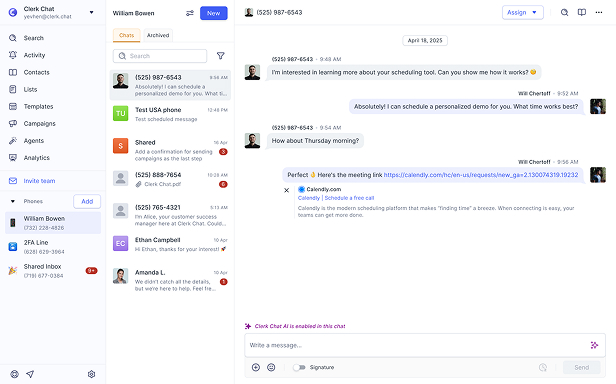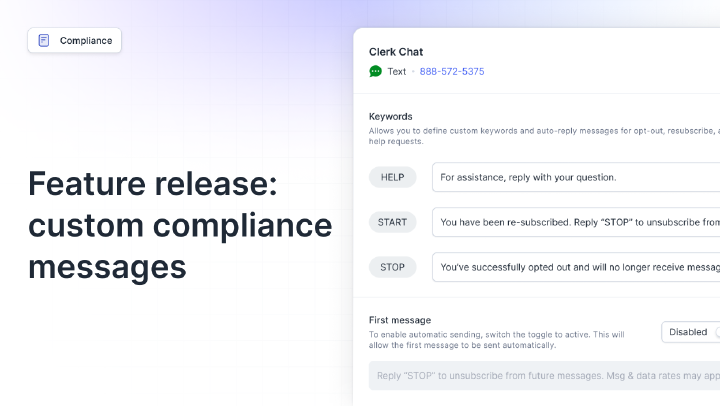SMS opt-in
[ɛs ɛm ɛs ɒpt ɪn]Opt-in represents explicit permission from individuals allowing businesses to send them text messages, forming the legal foundation of compliant SMS marketing. This consent must be clear, documented, and freely given - protecting both businesses from costly violations and consumers from unwanted messages.
Why opt-in matters
Opt-in consent stands as the single most critical element of business texting, with implications far beyond legal compliance. The Telephone Consumer Protection Act (TCPA) mandates explicit permission before sending marketing messages, with violations costing $500-1,500 per text. For a campaign mistakenly sent to 10,000 non-consenting numbers, that’s a potential $15 million liability from one click.
Beyond avoiding catastrophic fines, proper opt-in practices build sustainable messaging programs. Subscribers who actively choose to receive messages engage at rates 4x higher than those added through questionable methods. They purchase more frequently, complain less often, and remain subscribed longer. This self-selection creates an audience genuinely interested in your business, making every message more valuable.
The trust factor cannot be overlooked. In an era where consumers guard personal information fiercely, respecting opt-in preferences demonstrates integrity. Businesses using transparent opt-in processes through platforms like Clerk Chat report 85% fewer spam complaints and 60% higher customer lifetime value. By making consent the cornerstone of your messaging strategy, you transform compliance from a burden into a competitive advantage that strengthens customer relationships.
How opt-in works
The opt-in process involves multiple technical and legal components working together:
Consent Collection: Customers provide their phone numbers through various methods - web forms, point-of-sale systems, keyword texting, paper forms, or verbal agreement (followed by written confirmation).
Disclosure Presentation: At the point of collection, clear disclosures explain what types of messages subscribers will receive, approximate frequency, and that message and data rates may apply.
Active Agreement: Customers must take affirmative action to consent. Pre-checked boxes, assumed consent, or buried terms don’t constitute valid opt-in under TCPA guidelines.
Record Creation: Systems capture consent details including timestamp, IP address (for digital opt-ins), consent method, exact disclosure language shown, and customer identification.
Confirmation Message: Immediately upon opt-in, businesses send confirmation texts reiterating what subscribers signed up for and providing clear opt-out instructions.
Database Integration: Opt-in records sync with messaging platforms, CRM systems, and compliance databases to prevent unauthorized messaging and enable consent verification.
Ongoing Maintenance: Regular audits verify consent validity, remove expired permissions, and update records when customers change their preferences or phone numbers.
Best practices with opt-in
Create Crystal-Clear Disclosure Language - Write opt-in disclosures at an 8th-grade reading level. State exactly what messages subscribers will receive: “Get 2-4 texts/month about sales and new products. Msg & data rates apply. Reply STOP to cancel.”
Implement Multi-Channel Opt-in Collection - Deploy opt-in opportunities across all customer touchpoints: website popups (25% conversion), checkout flows (40% conversion), in-store signage (15% conversion), and receipt prompts (30% conversion).
Use Progressive Opt-in Strategies - Start with transactional message consent during account creation, then invite engaged customers to receive promotional content. This staged approach builds trust while expanding permissions.
Document Everything with Automated Systems - Capture screenshots of web forms, store API logs of digital opt-ins, and maintain unchangeable records. Modern platforms handle this automatically, but verify your documentation meets legal standards.
Send Immediate Welcome Messages - Confirm opt-in within 5 minutes with a message that includes business name, message frequency, opt-out instructions, and a value-add like a discount code to reinforce positive decision.
Audit and Clean Your Lists Regularly - Review opt-in records quarterly, remove subscribers inactive for 12+ months, and re-confirm consent when changing message types or frequency substantially.
Train Every Team Member on Compliance - Ensure all staff understand opt-in requirements. One untrained employee adding numbers manually can trigger massive fines. Create simple scripts and systems that make compliance automatic.
Real world examples
- Retail
Built 50K subscriber list using point-of-sale opt-in prompts
Read more - Healthcare
Achieved 95% opt-in rate for appointment reminders during registration
Read more
Common misconceptions
TCPA requires written consent for marketing messages. Document all opt-ins with timestamp, method, and explicit agreement terms.
Consent expires if no messages sent for 18 months. Best practice is confirming continued interest annually.
Opt-in consent cannot be transferred or sold. Each business must obtain direct permission from customers.
Even transactional texts need prior consent. Only emergency alerts bypass opt-in requirements under FCC rules.
Different message types require separate consent. Marketing opt-in doesn't permit account alerts or promotional content.
Related terms
In this article:
Ready to use your business number for text messaging?
Thousands of businesses are already experiencing the power of conversational messaging through SMS. Join us. Free trial and paid tiers available.
Get StartedFAQ
Have questions? We've got answers.
Find what you need quickly and clearly with our most frequently asked questions.
Valid opt-in requires clear, written consent where customers knowingly agree to receive specific types of messages from your business. This includes electronic signatures on forms, checking unchecked boxes (not pre-checked), texting keywords to short codes, or submitting mobile numbers through web forms with clear SMS disclosure. The consent must specify message frequency, types, and standard rates apply. Verbal consent alone doesn't meet TCPA requirements for marketing messages.
Create multiple opt-in touchpoints across customer journeys. Design web forms with clear SMS consent language, implement keyword campaigns (text JOIN to 12345), add opt-in checkboxes to checkout processes, and train staff to collect written consent during in-person interactions. Use platforms like Clerk Chat to automatically track consent records with timestamps. Always send immediate confirmation messages stating what subscribers signed up for and how to opt-out.
TCPA violations carry severe penalties: $500-$1,500 per unauthorized message. Class action lawsuits can reach millions - Dish Network paid $280 million for SMS violations. Beyond fines, businesses face carrier filtering, number suspension, and reputation damage. Individual consumers can sue directly without proving actual harm. Even accidental violations due to poor record-keeping or transferred numbers can result in significant penalties.
Single opt-in requires one action - submitting a form or texting a keyword. Double opt-in adds a confirmation step where subscribers must reply YES or click a link to confirm their subscription. While double opt-in reduces list size by 20-30%, it provides stronger legal protection and higher engagement rates. Financial services and healthcare often require double opt-in, while retail typically uses single opt-in with clear disclosures.
Opt-in consent doesn't expire automatically but becomes questionable after 18 months of inactivity. Best practices include sending annual consent renewal messages and removing inactive subscribers after one year. Consent remains valid as long as you message regularly (at least quarterly) and stay within the scope of original permission. Major changes to message frequency or content type require fresh opt-in consent.
No, opt-in consent is channel-specific. Email subscribers must separately opt-in for SMS, even if they're existing customers. You can invite email subscribers to join SMS lists but cannot automatically enroll them. Create targeted email campaigns explaining SMS benefits and including simple opt-in methods. Many businesses see 15-25% of engaged email subscribers also joining SMS when properly invited.




